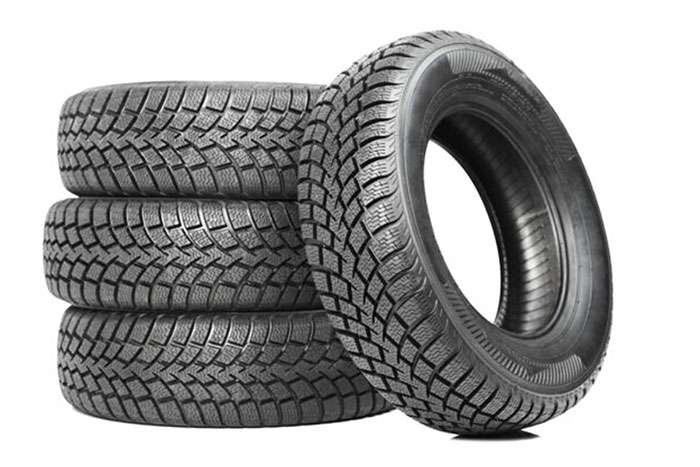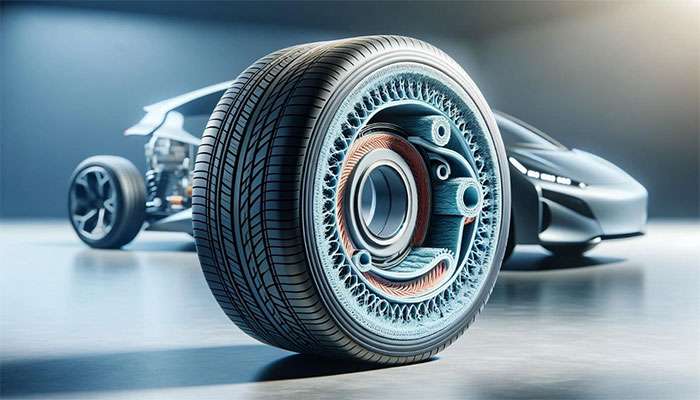
Electric vehicle sales jumped 80% in 2021, and drivers are discovering something important: do electric cars need special tires? The answer is absolutely yes. More than a third of EVs weigh over 4,400 pounds, creating demands that standard tires cannot handle.
Electric vehicles stress tires far more than gas-powered cars, wearing them out faster. The culprit? Heavy battery packs and instant torque delivery that puts tremendous force on your tires. EV tires vs regular tires show major construction differences, with EV-specific options featuring high-load capacity designs (HL tires) built specifically for heavier vehicles.
We know that choosing the right tires for your electric vehicle affects everything from driving range to ride comfort. This guide covers why EV tires are different, how they're engineered for better performance, and what makes them essential for getting the most from your electric vehicle. We'll also provide practical advice for selecting the best tires for your specific EV model.
Electric vehicles present challenges that conventional tire technology wasn't built to handle. Tire shops often recommend replacements much earlier than EV owners expect. This happens because electric vehicles create unique stress patterns that accelerate tire wear.
Battery weight is the primary reason for accelerated tire wear. EVs typically weigh 20-30% more than their gas-powered counterparts. Consider this comparison: a Toyota Camry weighs approximately 1,500 kg, while a Tesla Model 3 weighs 1,800 kg. EV battery packs alone can weigh between 500-1,200 pounds, with larger models carrying batteries up to 2,000 pounds.
This extra weight affects your vehicle through two different load types:
Sprung weight: portions supported by suspension (cabin, battery)
Unsprung weight: components directly connected to the road (wheels, tires)
Higher unsprung weight creates greater force on tires when driving over uneven surfaces. The result? Faster sidewall and tread wear.
Electric motors deliver 100% of their torque instantaneously. This immediate power transfer explains why EVs can outperform high-performance sports cars during acceleration tests. However, this characteristic places tremendous stress on your tires.
Gas engines build power gradually through gear shifts. EVs apply maximum force instantly whenever you press the accelerator. Tire scrubbing increases substantially, particularly during acceleration from a standstill. Combined with weight, torque, and minimal coasting due to regenerative braking, tires on EVs wear 20-30% faster than on conventional vehicles.
These demanding conditions require fundamental structural enhancements. EV tires feature reinforced sidewalls and more robust steel belt packages designed to support 20-30% more weight. The rubber compounds also differ, with specialized formulations providing approximately 30% better wear resistance.
Manufacturers like Continental have developed tires such as the EcoContact 6 with optimized tread compounds and patterns specifically for EVs. These tires balance enhanced grip, lower rolling resistance, and durability against the intense forces generated by electric drivetrains.

Image Source: Bartell Machinery
Tire manufacturers have developed specialized construction techniques to meet electric vehicle demands. Battery technology continues advancing, which means tire design must keep pace to handle increased weight and torque while maintaining efficiency and comfort.
The European Tire and Rim Technical Organization (ETRTO) created a new "High Load" (HL) tire standard in 2021 specifically for electric vehicles. HL tires look similar in size to standard tires, but they support significantly more weight than conventional or even XL (Extra Load) tires. At the same pressure, an HL tire with a load index of 98 can carry over 1,600 pounds (726 kg), while a comparable XL tire with load index 94 supports just under 1,500 pounds (680 kg).
HL tires feature reinforced sidewalls and more robust internal construction. Manufacturers like Michelin achieve this through advanced construction techniques that combine stronger materials with innovative engineering. Some EV tires incorporate aramid (similar to Kevlar) rather than nylon in the tire carcass, providing superior strength without sacrificing flexibility.
Electric vehicles deliver maximum torque instantly, so tire compounds must balance grip with durability. Continental's EcoContact 6 uses their Green Chili 2.0 compound with special grip additives to enhance braking performance. Other manufacturers employ liquid phase mixing technology like EcoPoint³, which creates the optimal balance between rolling resistance, wear resistance, and grip.
Engineers are developing multi-compound tires with different rubber formulations for the shoulder versus the center. These compounds must be rigid enough to handle torque while remaining efficient enough to maximize range.
EV tires often feature asymmetric tread designs that serve multiple purposes. The center section typically has ribbed patterns to reduce rolling resistance, while shoulder sections optimize grip for cornering. This design balances the competing demands of efficiency and performance.
These tread patterns incorporate smaller blocks and shallower grooves to minimize vibrations and air turbulence. Many include additional sipes (small slits) for improved traction on slippery surfaces. Every aspect of the tread geometry is calibrated to optimize the contact patch—the area where tire meets road—ensuring even pressure distribution despite the vehicle's weight.

Image Source: Tire Pte Ltd
The right tires can make the difference between running out of charge before reaching your destination and arriving with power to spare. EV-specific tires tackle performance challenges that standard tires simply can't handle.
Rolling resistance hits EVs about three times harder than gas-powered vehicles. This energy drain - the force needed to keep your tire rolling at steady speed - directly cuts into your driving range. Every bit of wasted energy means fewer miles per charge.
The numbers tell the story: tires account for 34-37% of total energy loss in EVs, compared to just 20-25% in combustion engines. That's a massive difference. Manufacturers fight this energy drain through specialized sidewall construction, optimized tread patterns, and advanced rubber compounds that slice through resistance.
Electric vehicles reveal something gas cars hide - tire noise. Without engine sound masking it, tire noise jumps to 40% of an EV's total sound versus 30% in conventional cars. The solution? Manufacturers now pack polyurethane foam inside tires, cutting interior noise by roughly 20%.
These acoustic technologies go beyond basic foam. Specialized inlays dampen cavity resonance by up to 9 decibels. Engineers add knurling technology and chamfer designs that break up sound frequencies before they reach your ears.
Tire aerodynamics matter more than most drivers realize. Manufacturers use AI simulations to map airflow around tires, creating shapes that slice through air resistance. Smart sidewall design can boost range by up to 4%.
Even small changes add up. Each inch increase in wheel size typically costs about 5% of your driving range. For EV owners watching every mile, these details make a real difference in daily driving.
Selecting the right tires for your electric vehicle makes the difference between good performance and exceptional results. Here's what you need to know about EV tire selection and care.
EV-specific tires feature reinforced construction designed to handle battery weight and instant torque delivery. These tires carry higher load ratings, reduced rolling resistance, and noise-dampening technology. Major manufacturers now offer EV-ready options with clear sidewall markings like "EV" or "Electric" for easy identification.
EV tires cost between $150-$300 per tire—about 20-40% more than standard options. However, their specialized engineering provides better long-term value through extended lifespan and improved vehicle performance.
Winter driving creates additional challenges for electric vehicles. When temperatures drop below 45°F, specialized winter tires become essential for safety and performance. EV winter tires use compounds that stay flexible in cold weather while supporting heavier vehicle weights.
The Michelin X-Ice Snow offers low rolling resistance specifically designed to preserve driving range during winter months. For extreme conditions, the Nokian Hakkapeliitta 10 EV features star-shaped studs positioned for maximum grip on icy surfaces.
Proper inflation is critical for EV performance—underinflated tires can cut your range by up to 4%. Most electric vehicles require higher pressures (42-45 PSI versus 30-35 PSI for gas cars) to support the additional weight. Check pressure monthly, as tires lose approximately 1 PSI every 30 days.
Rotate tires every 5,000-7,500 miles following manufacturer recommendations. For electric vehicles, stick closer to 5,000-mile intervals to manage accelerated wear patterns. Schedule alignment checks every six months to prevent uneven wear that develops faster in heavier EVs.
EV tires typically last 30,000-40,000 miles before replacement becomes necessary. Watch for these warning signs:
Tread depth at 2/32 inch or less (wear bars visible or penny test failure)
Uneven wear patterns indicating alignment problems
Noticeable decrease in vehicle range
Poor handling or increased road noise
For the best selection of specialized options designed specifically for electric vehicles, visit the EV Performance Tire Page to explore tires engineered for your EV's unique requirements.
The science behind EV tires proves that specialized options deliver real performance advantages for electric vehicle owners. These tires tackle the core challenges that make EVs different - heavy battery packs, instant torque, and cabin noise - making tire selection a crucial decision for range, comfort, and safety.
The engineering advances we've covered show that EV tires offer genuine benefits, not marketing claims. Reinforced sidewalls, optimized compounds, and noise reduction technology provide advantages that standard tires cannot match.
EV tire care demands attention to detail. Higher inflation pressures and more frequent rotations help manage the accelerated wear from extra weight and torque. Winter conditions require specialized options that maintain safety while preserving efficiency.
EV-specific tires cost 20-40% more than standard options, but their specialized engineering provides better long-term value. For drivers looking to maximize their electric vehicle's potential, the EV Performance Tire Page offers specialized options designed specifically for your vehicle.
Electric vehicles continue changing how we drive, and their tire requirements show how every component must evolve with the technology. The right tires extend your driving range and enhance the quiet, responsive experience that makes EVs appealing in the first place.
Electric vehicles demand specialized tires due to their unique engineering challenges, and understanding these requirements is crucial for maximizing performance, safety, and efficiency.
• EVs are 20-30% heavier than gas cars due to battery packs, requiring High Load (HL) tires with reinforced construction to handle the extra weight and prevent premature wear.
• Instant torque delivery stresses tires significantly - EVs apply maximum force immediately, causing 20-30% faster tire wear compared to conventional vehicles that gradually build power.
• EV-specific tires improve range by up to 4% through reduced rolling resistance, aerodynamic designs, and specialized compounds that minimize energy loss during driving.
• Acoustic foam technology reduces cabin noise by 20% - essential since tire noise becomes much more noticeable in quiet electric vehicles without engine sound masking.
• Proper maintenance extends tire life significantly - maintain higher air pressure (42-45 PSI), rotate every 5,000 miles, and expect replacement around 30,000-40,000 miles for optimal performance.
While EV tires cost 20-40% more than standard options, their specialized engineering provides better long-term value through enhanced durability, improved efficiency, and superior comfort tailored specifically for electric vehicle demands.
Electric vehicles require special tires due to their heavier weight from battery packs and instant torque delivery. These factors cause increased stress on tires, leading to faster wear. EV-specific tires are designed with reinforced construction and specialized compounds to handle these unique demands.
EV tires improve driving range by reducing rolling resistance, which is the energy required to keep a tire rolling. They feature optimized tread patterns, advanced rubber compounds, and aerodynamic designs that minimize energy loss. These improvements can extend an EV's range by up to 4%.
Yes, EV tires typically cost 20-40% more than standard tires. However, their specialized design often provides better long-term value through extended lifespan and improved vehicle performance, making them a worthwhile investment for EV owners.
It's recommended to rotate tires on an electric vehicle every 5,000-7,500 miles, or according to the manufacturer's recommendations. Due to the increased wear from EV weight and torque, earlier rotation intervals (closer to 5,000 miles) are often beneficial for maintaining even tire wear.
Yes, electric vehicles benefit from specialized winter tires, especially in temperatures below 45°F. EV winter tires feature compounds that remain flexible in cold conditions while maintaining the necessary load-bearing capacity. They also incorporate designs to enhance grip on icy surfaces and maintain low rolling resistance to help preserve range during winter months.